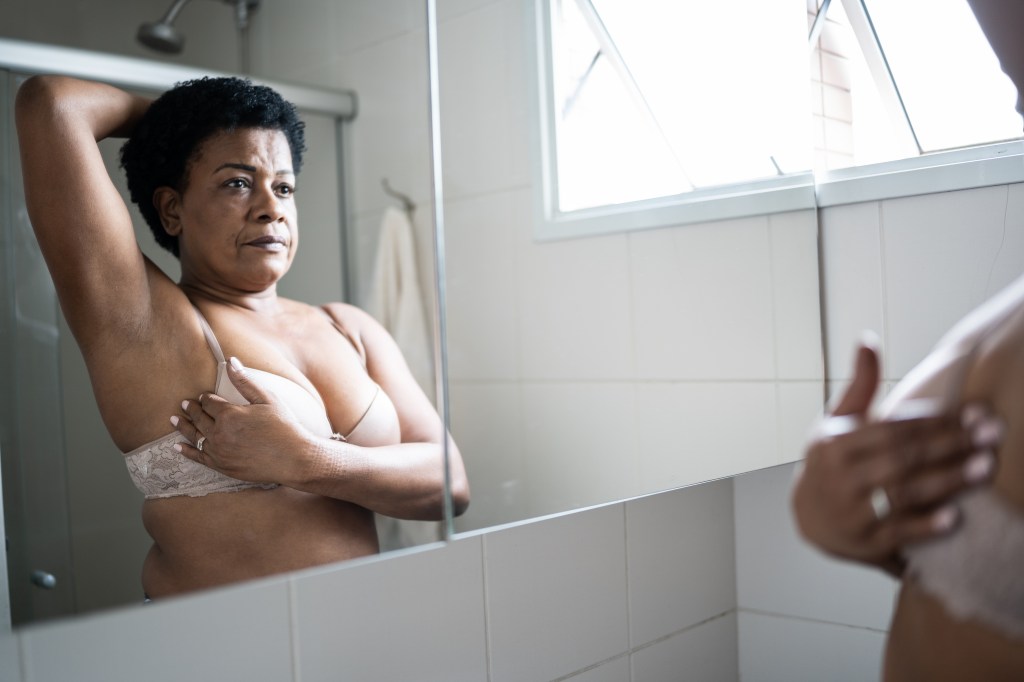Getting a diagnosis of breast cancer is terrifying — and, increasingly, all too common. A recent study found that while breast cancer deaths are declining, the number of cases is going up, meaning that more and more people are navigating the pain and anxiety of treatment while staying afloat emotionally and financially. And for Black women, the numbers continue to be dire.
Black women are more likely to die of breast cancer, with a 38 percent higher death rate than white women, according to a recent study. They’re also likely to be diagnosed with later-stage breast cancer, including metastatic breast cancer, and at a younger age, Dr. Christopher McGreevy, associated chief of breast surgery at the Hackensack University Medical Center, tells SheKnows.
The disparity is significant and concerning, with many factors coming into play, from systemic racism and discrimination to healthcare access. When it comes to breast cancer treatment and prevention, knowledge is power, which is why SheKnows spoke with Dr. McGreevy to explore what it means to have metastatic breast cancer, why Black women are at higher risk, and — most importantly — what they can do about it.
What Is Metastatic Breast Cancer?
Metastatic breast cancer or stage 4 breast cancer is “a type of cancer that originated in the breast and has spread to other parts of the body,” Dr. McGreevy explains. The cancer can spread through the bloodstream or the lymphatic system to anywhere in the body, and it’s most common for breast cancer to spread to the bones, lungs, liver, and brain, Dr. McGreevy says.
Metastatic breast cancer is a late-stage cancer, which means it’s considered incurable with a low chance of long-term survival. However, “it can be treated to help control the disease and improve the quality of life for patients,” Dr. McGreevy notes. Those treatments might include surgery, chemotherapy, radiation therapy, hormone therapy, and targeted therapy.
More Common in Black Women
Research has found that Black women are more likely to be diagnosed with advanced breast cancer and at a younger age, along with having a worse survival rate. In fact, when compared to white women, Black women are twice as likely to be diagnosed with triple-negative breast cancer, an aggressive type of cancer more likely to be found when it’s already spread to other parts of the body.
This stark disparity “is complex and multi-faceted,” says Dr. McGreevy, who noted several different contributing factors.
Access to healthcare: Since early breast cancer doesn’t typically show any symptoms, regular screenings are crucial to catching it before it progresses. But issues of cost and disparities in health insurance coverage translate to limited access to screenings and early detection for Black women, Dr. McGreevy says. According to a 2024 analysis by KFF, Black people were 1.5 times as likely to be uninsured compared to white people, and studies have shown that uninsured people are more likely to see cost as a barrier to getting a mammogram.
Poverty: Black women are disproportionately affected by poverty, according to 2020 data from the Center of American Progress: while Black women make up just 12.8 percent of the total population of women in the US, they represent 22.3 percent of women in poverty. And while poverty represents a financial barrier to getting regular mammograms, it also contributes to the healthcare disparity in other ways, leading to “food insecurity, lack of access to healthy foods, and limited access to quality healthcare” in general, Dr. McGreevy explains.
Racism: Black women are more likely to report being treated unfairly by a health care provider due to their race and ethnicity, according to a 2024 KFF survey. Because of that bias and discrimination, 34 percent of Black women who used health care in the past three years reported that a negative experience with a healthcare provider resulted in worse health, being less likely to seek care, and/or switching providers. When it comes to breast cancer, this kind of discrimination and distrust of healthcare providers can lead to delayed diagnosis and treatment.
Genetics: While Black women have similar rates of breast cancer-related genetic mutations compared to white women, they do have a higher prevalence of BRCA1 and BRCA2 mutations. People with these mutations have a higher risk of developing several cancers, including breast cancer and ovarian cancer, according to the National Cancer Institute.
Lowering Your Risk For Breast Cancer
Tackling the disparity in breast cancer outcomes won’t be simple, Dr. McGreevy says. “I’m an advocate of allocating more resources to research on the biological and social factors contributing to breast cancer disparities,” he explains. “This includes funding for studies on genetic risk factors, tumor biology, environmental exposures, and social determinants of health, specifically looking at treatment differences in different populations.” Also important: expanding access to healthcare and addressing implicit bias in healthcare settings.
On an individual level, though, what can you do to lower your breast cancer risk? While you can’t change any genetic risk factors, you can get tested to see if you have any mutations that put you at risk, which Dr. McGreevy especially recommends if you have a family history of breast cancer. On top of that, Dr. McGreevy says there are several lifestyle factors that put you in the best position to stay healthy and cancer-free. They include:
Maintaining a healthy weight, as obesity is a risk factor for breast cancer.
Staying active. Dr. McGreevy recommends aiming for at least 150 minutes of moderate-intensity exercise or 75 minutes of vigorous exercise every week.
Limit your alcohol consumption. Studies have found that “excessive alcohol consumption increases the risk of breast cancer,” Dr. McGreevy notes. He suggests limiting your alcohol intake to no more than one drink per day, but the lower the better, according to recent research.
Quitting smoking, which Dr. McGreevy says is the most important thing you can do to reduce risk. “Smoking increases the risk of many types of cancer, including breast cancer,” he explains.
Eat a healthy, balanced diet. “Choose a diet rich in fruits, vegetables, whole grains, and lean protein. Limit processed foods, sugary drinks, and unhealthy fats,” Dr. McGreevy says.
Get regular mammograms. Women should get yearly mammograms starting at age 40, but you should also talk to your doctor to see if your individual risk factors warrant earlier testing.
Before you go, shop these useful gifts and products for breast cancer patients and survivors:






